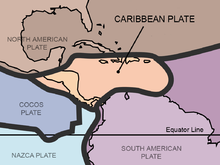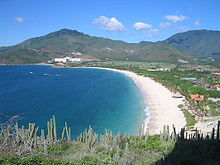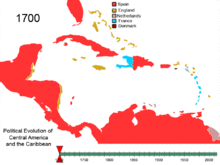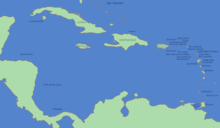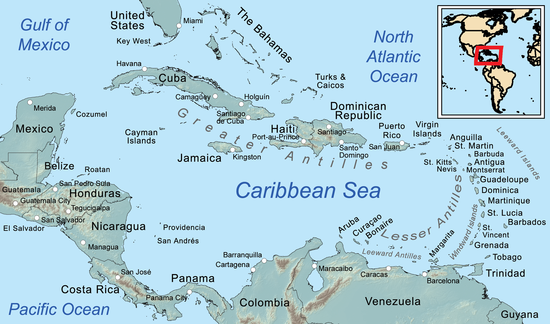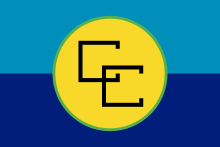- Caribbean
-
"West Indian" and "West Indies" redirect here. For other uses, see West India, West Indies (disambiguation) and Caribbean (disambiguation).
Caribbean 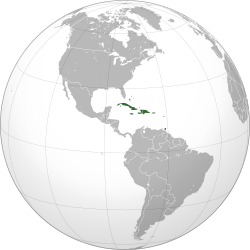
Area 2,754,000 km2 (1,063,000 sq mi) Land area 239,681 km2 (92,541 sq mi) Population (2009) 39,169,962[1] Density 151.5 /km2 (392 /sq mi) Ethnic groups Afro-Caribbean, Indo-Caribbean, Chinese Caribbean,[2] Amerindians (Arawak, Caribs, Taínos), European Demonym West Indian, Caribbean person, Caribbean Languages Spanish, English, French, Dutch and many others Government 13 sovereign states
17 dependent territoriesLargest cities Santo Domingo
Havana
Santiago de los Caballeros
Port-au-Prince
Kingston
Santiago de Cuba
San Juan
HolguínInternet TLD Multiple Calling code Multiple Time zone UTC-5 to UTC-4 The Caribbean (pronounced /ˌkærɨˈbiːən/ or /kəˈrɪbiən/[3]) is a region consisting of the Caribbean Sea, its islands (most of which are enclosed by the sea), and the surrounding coasts. The region is located southeast of the Gulf of Mexico and North America, east of Central America, and to the north of South America.
Situated largely on the Caribbean Plate, the region comprises more than 7,000 islands, islets, reefs, and cays. These islands, called the West Indies, generally form island arcs that delineate the eastern and northern edges of the Caribbean Sea.[4] These islands are called the West Indies because when Christopher Columbus landed there in 1492 he believed that he had reached to the west of the Indian sub-continent.[citation needed][dubious ]
The region consists of the Antilles, divided into the larger Greater Antilles which bound the sea on the north, the Lesser Antilles on the south and east (including the Leeward Antilles), the Bahamas, and the Turks and Caicos Islands or the Lucayan Archipelago, which are in fact in the Atlantic Ocean north of Cuba, not in the Caribbean Sea.
Geopolitically, the West Indies are usually regarded as a subregion of North America[5][6][7][8][9] and are organized into 30 territories including sovereign states, overseas departments, and dependencies. From January 3, 1958, to May 31, 1962, there was a short-lived country called the Federation of the West Indies composed of ten English-speaking Caribbean territories, all of which were then UK dependencies. The West Indies cricket team continues to represent many of those nations.
Contents
Etymology
The region takes its name from that of the Carib, an ethnic group present in the Lesser Antilles and parts of adjacent South America at the time of European contact.[10]
Definition
The word "Caribbean" has multiple uses. Its principal ones are geographical and political. The Caribbean can also be expanded to include territories with strong cultural and historical connections to slavery, European colonisation and the plantation system.
- Physiographically, the Caribbean region consists mainly of the Caribbean Sea to north, bordered by the Gulf of Mexico, the Straits of Florida, the Northern Atlantic Ocean which lies to the east and northeast, and a chain of islands surrounding the Caribbean Sea; the coastline of the continent of South America lies to the south.
- Politically, "Caribbean" may be centred on socio-economic groupings found in the region. For example the block known as the Caribbean Community (CARICOM) contains both the Co-operative Republic of Guyana and the Republic of Suriname found in South America, along with Belize in Central America as full members. Bermuda and the Turks and Caicos Islands which are found in the Atlantic Ocean are associate members of the Caribbean Community, and the same goes for the Commonwealth of the Bahamas which is a full member of the Caribbean Community.
- Alternately the organisation known as the Association of Caribbean States (ACS) consists of almost every nation in the surrounding regions which lie on the Caribbean plus El Salvador which lies solely on the Pacific Ocean. According to the ACS the total population of its member states is some 227 million people.[11]
Geography and climate
The geography and climate in the Caribbean region varies. Some islands in the region have relatively flat terrain of non-volcanic origin. These islands include Aruba (possessing only minor volcanic features), Barbados, Bonaire, the Cayman Islands, Saint Croix, The Bahamas or Antigua. Others possess rugged towering mountain-ranges like the islands of Cuba, Hispaniola, Puerto Rico, Jamaica, Dominica, Montserrat, Saba, Saint Kitts, Saint Lucia, Saint Thomas, Saint John, Tortola, Grenada, Saint Vincent, Guadeloupe, Martinique, and Trinidad & Tobago.
The climate of the region is tropical but rainfall varies with elevation, size and water currents (cool upwellings keep the ABC islands arid). Warm, moist tradewinds blow consistently from the east creating rainforest/semidesert divisions on mountainous islands. Occasional northwesterlies affect the northern islands in the winter. The region enjoys year-round sunshine, divided into 'dry' and 'wet' seasons, with the last six months of the year being wetter than the first half.
The waters of the Caribbean Sea host large, migratory schools of fish, turtles, and coral reef formations. The Puerto Rico trench, located on the fringe of the Atlantic Ocean and Caribbean Sea just to the north of the island of Puerto Rico, is the deepest point in all of the Atlantic Ocean.[12]
Hurricanes, which at times batter the region, usually strike northwards of Grenada, and to the west of Barbados. The principal hurricane belt arcs to northwest of the island of Barbados in the Eastern Caribbean.
The region sits in the line of several major shipping routes with the man-made Panama Canal connecting the western Caribbean Sea with the Pacific Ocean.
 Beach in Tobago
Beach in Tobago Puerto Cruz beach in Margarita Island, Venezuela
Puerto Cruz beach in Margarita Island, Venezuela
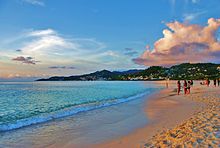 Grand Anse beach, St. George's, Grenada
Grand Anse beach, St. George's, Grenada
Island groups
 Bahamas
Bahamas Turks and Caicos Islands (United Kingdom)
Turks and Caicos Islands (United Kingdom)
 Cuba
Cuba- Hispaniola
 Jamaica
Jamaica Cayman Islands (United Kingdom)
Cayman Islands (United Kingdom) Puerto Rico (U.S. Commonwealth)
Puerto Rico (U.S. Commonwealth)
- Leeward Islands
 U.S. Virgin Islands
U.S. Virgin Islands
- Saint Croix
- Saint Thomas
- Saint John
- Water Island
 British Virgin Islands (United Kingdom)
British Virgin Islands (United Kingdom)
 Anguilla (United Kingdom)
Anguilla (United Kingdom) Antigua and Barbuda
Antigua and Barbuda
- Saint Martin
 Saint Martin (French Antilles, France)
Saint Martin (French Antilles, France) Sint Maarten (Kingdom of the Netherlands)
Sint Maarten (Kingdom of the Netherlands)
 Saba (BES islands, Netherlands)
Saba (BES islands, Netherlands) Sint Eustatius (BES islands, Netherlands)
Sint Eustatius (BES islands, Netherlands) Saint Barthélemy (French Antilles, France)
Saint Barthélemy (French Antilles, France) Saint Kitts and Nevis
Saint Kitts and Nevis
 Montserrat (United Kingdom)
Montserrat (United Kingdom) Guadeloupe (French Antilles, France) including
Guadeloupe (French Antilles, France) including
- les Saintes
- Marie-Galante
- la Désirade
- Windward Islands
 Dominica
Dominica Martinique (French Antilles, France)
Martinique (French Antilles, France) Saint Lucia
Saint Lucia Saint Vincent and the Grenadines
Saint Vincent and the Grenadines
- Saint Vincent
- The Grenadines
 Grenada
Grenada
 Barbados
Barbados Trinidad and Tobago
Trinidad and Tobago
- Leeward Antilles
 Aruba (Kingdom of the Netherlands)
Aruba (Kingdom of the Netherlands) Curaçao (Kingdom of the Netherlands)
Curaçao (Kingdom of the Netherlands) Bonaire (BES islands, Netherlands)
Bonaire (BES islands, Netherlands)
Historical groupings
Main article: History of the CaribbeanAll islands at some point were, and a few still are, colonies of European nations; a few are overseas or dependent territories:
- British West Indies/Anglophone Caribbean – Anguilla, Antigua and Barbuda, Bahamas, Barbados, Bay Islands, Belize, British Virgin Islands, Cayman Islands, Dominica, Grenada, Guyana, Jamaica, Montserrat, Saint Croix (briefly), Saint Kitts and Nevis, Saint Lucia, Saint Vincent and the Grenadines, Trinidad and Tobago (from 1797) and the Turks and Caicos Islands
- Danish West Indies – present-day United States Virgin Islands
- Dutch West Indies – Aruba, Curaçao, Saba, Sint Eustatius, Sint Maarten, Virgin Islands, Saint Croix (briefly), Tobago and Bay Islands (briefly)
- French West Indies – Anguilla (briefly), Antigua and Barbuda (briefly), Dominica, Dominican Republic (briefly), Grenada, Haiti, Montserrat (briefly), Saint Lucia, Saint Vincent and the Grenadines, Sint Eustatius (briefly), Sint Maarten, St. Kitts (briefly), Tobago (briefly), Saint Croix, the current French overseas départements of Martinique and Guadeloupe (including Marie-Galante, La Désirade and Les Saintes), and the current French overseas collectivities of Saint Barthélemy and Saint Martin
- Portuguese West Indies – present-day Barbados, known as Os Barbados in the 16th century when the Portuguese claimed the island en route to Brazil. The Portuguese left Barbados abandoned in 1533, nearly a century prior to the British arrival to the island.
- Spanish West Indies – Cuba, Hispaniola (present-day Dominican Republic, Haiti (until 1609 to France)), Puerto Rico, Jamaica (until 1655 to Great Britain), the Cayman Islands (until 1670 to Great Britain) Trinidad (until 1797 to Great Britain) and Bay Islands (until 1643 to Great Britain), coastal islands of Central America (minus Belize), and some Caribbean coastal islands of Colombia, Mexico, and Venezuela.
- Swedish West Indies – present-day French Saint-Barthélemy and Guadeloupe (briefly).
- Courlander West Indies – Tobago (until 1691)
The British West Indies were united by the United Kingdom into a West Indies Federation between 1958 and 1962. The independent countries formerly part of the B.W.I. still have a joint cricket team that competes in Test matches, One Day Internationals and Twenty20 Internationals. The West Indian cricket team includes the South American nation of Guyana, the only former British colony on that continent.
In addition, these countries share the University of the West Indies as a regional entity. The university consists of three main campuses in Jamaica, Barbados and Trinidad and Tobago, a smaller campus in the Bahamas and Resident Tutors in other contributing territories such as Trinidad.
Modern day island territories
Main article: List of islands in the CaribbeanSee also: Caribbean South America and Caribbean basin Anguilla (British overseas territory)
Anguilla (British overseas territory) Antigua and Barbuda (Constitutional monarchy)
Antigua and Barbuda (Constitutional monarchy) Aruba (Kingdom of the Netherlands)
Aruba (Kingdom of the Netherlands) Bahamas (Constitutional monarchy)
Bahamas (Constitutional monarchy) Barbados (Constitutional monarchy)
Barbados (Constitutional monarchy) Bonaire (special municipality of the Netherlands)
Bonaire (special municipality of the Netherlands) British Virgin Islands (British overseas territory)
British Virgin Islands (British overseas territory) Cayman Islands (British overseas territory)
Cayman Islands (British overseas territory) Cuba (Republic)
Cuba (Republic) Curaçao (Kingdom of the Netherlands)
Curaçao (Kingdom of the Netherlands) Dominica (Republic)
Dominica (Republic) Dominican Republic
Dominican Republic Grenada (Constitutional monarchy)
Grenada (Constitutional monarchy) Guadeloupe (overseas department of France) including
Guadeloupe (overseas department of France) including
- les Saintes
- Marie-Galante
- la Désirade
 Haiti (Republic)
Haiti (Republic) Jamaica (Constitutional monarchy)
Jamaica (Constitutional monarchy) Martinique (overseas department of France)
Martinique (overseas department of France) Montserrat (British overseas territory)
Montserrat (British overseas territory) Puerto Rico (commonwealth of the United States)
Puerto Rico (commonwealth of the United States) Saba (Netherlands)
Saba (Netherlands) Saint Barthélemy (overseas collectivity of France)
Saint Barthélemy (overseas collectivity of France) Saint Kitts and Nevis (Constitutional monarchy)
Saint Kitts and Nevis (Constitutional monarchy) Saint Lucia (Constitutional monarchy)
Saint Lucia (Constitutional monarchy) Saint Martin (overseas collectivity of France)
Saint Martin (overseas collectivity of France) Saint Vincent and the Grenadines (Constitutional monarchy)
Saint Vincent and the Grenadines (Constitutional monarchy) Sint Eustatius (special municipality of the Netherlands)
Sint Eustatius (special municipality of the Netherlands) Sint Maarten (Kingdom of the Netherlands)
Sint Maarten (Kingdom of the Netherlands) Trinidad and Tobago (Republic)
Trinidad and Tobago (Republic) Turks and Caicos Islands (British overseas territory)
Turks and Caicos Islands (British overseas territory) United States Virgin Islands (territory of the United States)
United States Virgin Islands (territory of the United States)
Continental countries with Caribbean coastlines and islands
 Belize
Belize
- Ambergris Caye
- Belize City
- Big Creek
- Caye Caulker
- Glover's Reef
- Dangriga
- Hicks Cays
- Hopkins
- Lighthouse Reef
- Placencia
- Punta Gorda
- St. George's Caye
- South Water Caye
- Turneffe Islands
 Colombia
Colombia
- Archipelago of San Andres and Providencia
- Barranquilla
- Cartagena
- Riohacha
- Santa Marta
 Costa Rica
Costa Rica Guatemala
Guatemala Honduras
Honduras
 Mexico
Mexico
- Quintana Roo
- Cancún
- Chetumal
- Cozumel
- Isla Contoy
- Isla Mujeres
- Quintana Roo
 Nicaragua
Nicaragua
- Corn Islands
- Cayos Miskitos
- Pearl Cays
 Panama
Panama
- Kuna Yala Islands (comprising more than 1300 islands)
- Bocas del Toro Archipelago (archipelago with approximately 300 islands)
 United States
United States
 Venezuela
Venezuela
Biodiversity
The Caribbean islands are remarkable for the diversity of their animals, fungi and plants, and have been classified as one of Conservation International's biodiversity hotspots because of their exceptionally diverse terrestrial and marine ecosystems, ranging from montane cloud forests to cactus scrublands. The region also contains about 8% (by surface area) of the world's coral reefs[14] along with extensive seagrass meadows,[15] both of which are frequently found in the shallow marine waters bordering island and continental coasts off the region.
For the fungi, there is a modern checklist based on nearly 90,000 records derived from specimens in reference collections, published accounts and field observations.[16] That checklist includes more than 11250 species of fungi recorded from the region. As its authors note, the work is far from exhaustive, and it is likely that the true total number of fungal species already known from the Caribbean is higher. The true total number of fungal species occurring in the Caribbean, including species not yet recorded, is likely to be far higher, given the generally accepted estimate that only about 7% of all fungi worldwide have so far been discovered.[17] Although the amount of available information is still very small, a first effort has been made to estimate the number of fungal species endemic to some Caribbean islands. For Cuba, 2200 species of fungi have been tentatively identified as possible endemics of the island;[18] for Puerto Rico, the number is 789 species;[19] for the Dominican Republic, the number is 699 species;[20] for Trinidad and Tobago, the number is 407 species.[21]
Many of the ecosystems of the Caribbean islands have been devastated by deforestation, pollution, and human encroachment. The arrival of the first humans is correlated with extinction of giant owls and dwarf ground sloths.[22] The hotspot contains dozens of highly threatened animals (ranging from birds, to mammals and reptiles), fungi and plants. Examples of threatened animals include the Puerto Rican Amazon, two species of solenodon (giant shrews) in Cuba and the Hispaniola island, and the Cuban crocodile.

Saona Island, Dominican Republic The region's coral reefs, which contain about 70 species of hard corals and between 500-700 species of reef-associated fishes[23] have undergone rapid decline in ecosystem integrity in recent years, and are considered particularly vulnerable to global warming and ocean acidification.[24]
Demographics
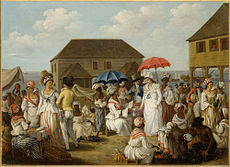 A linen market in Dominica in the 1770s
A linen market in Dominica in the 1770s
 Cuban school children
Cuban school children
The population of the Caribbean is estimated to have been around 750,000 immediately before European contact, although lower and higher figures are given. After contact, genocide and disease led to a decline in the Amerindian population.[25][26] From 1500 to 1800 the population rose as slaves arrived from West Africa[27] such as the Kongo, Igbo, Akan, Fon and Yoruba as well as military prisoners and captured slaves from Ireland, who were deported during the Cromwellian reign in England.[28] Immigrants from Britain, Italy. France, Spain, the Netherlands, Portugal and Denmark also arrived, although the mortality rate was high for both groups.[29]
The population is estimated to have reached 2.2 million by 1800.[30] Immigrants from India, China, and other countries arrived in the 19th century.[31] After the ending of the Atlantic slave trade, the population increased naturally.[32] The total regional population was estimated at 37.5 million by 2000.[33]
The majority of the Caribbean has populations of mainly Africans in the French Caribbean, Anglophone Caribbean and Dutch Caribbean, there are minorities of mixed-race and European peoples of Dutch, English, French, Italian and Portuguese ancestry. Asians, especially those of Chinese and Indian descent, form a significant minority in the region and also contribute to multiracial communities. All of their ancestors arrived in the 19th century as indentured laborers.
The Spanish-speaking Caribbean have primarily mixed race, African, or European majorities. Puerto Rico and Cuba (largest Caribbean island) have a European majority with a mixture of Spaniards–European, Amerindians, and some West African. One third of Cuba's population is of African descent, with a sizable Mulatto (mixed African–European) population. The Dominican Republic has a largely mixed majority who are primarily descended from West Africans and Spaniards, with some Amerindians.
Larger islands such as Jamaica, have a large African population in addition to a very large mixed race, Chinese, Europeans, Indian, Lebanese, Latin American, and Syrian populations. This is a result of years of importation of slaves and indentured labourers, and migration. Most multi-racial Jamaicans refer to themselves as either mixed race or simply Black. The situation is similar for the Caricom states of Guyana, Suriname and Trinidad and Tobago. Trinidad and Tobago has a multi-racial cosmopolitan society due to the arrival of the Africans, Indians, Chinese, Syrians, Lebanese, Native Amerindians and Europeans. This multi-racial mix has created sub-ethnicities that often straddle the boundaries of major ethnicities and include Chindian and Dougla.
Indigenous tribes
Language
Main article: Caribbean LanguagesSpanish, English, French, Dutch, Haitian Creole and Papiamento are the predominant official languages of various countries in the region, though a handful of unique Creole languages or dialects can also be found from one country to another.
Religion
See also: :Category:Religion in the CaribbeanChristianity is the predominant religion in the Caribbean. Other religious groups in the region are: Hinduism, Islam, Rastafari, Santería, and Voodoo among others.
Politics
Regionalism
Caribbean societies are very different from other Western societies in terms of size, culture, and degree of mobility of their citizens.[34] The current economic and political problems which the states face individually are common to all Caribbean states. Regional development has contributed to attempts to subdue current problems and avoid projected problems. From a political economic perspective, regionalism serves to make Caribbean states active participants in current international affairs through collective coalitions. In 1973, the first political regionalism in the Caribbean Basin was created by advances of the English-speaking Caribbean nations through the institution known as the Caribbean Common Market and Community (CARICOM).[35]
Certain scholars have argued both for and against generalizing the political structures of the Caribbean. On the one hand the Caribbean states are politically diverse, ranging from communist systems such as Cuba toward more capitalist Westminster-style parliamentary systems as in the Commonwealth Caribbean. Other scholars argue that these differences are superficial, and that they tend to undermine commonalities in the various Caribbean states. Contemporary Caribbean systems seem to reflect a "blending of traditional and modern patterns, yielding hybrid systems that exhibit significant structural variations and divergent constitutional traditions yet ultimately appear to function in similar ways."[36] The political systems of the Caribbean states share similar practices.
The influence of regionalism in the Caribbean is often marginalized. Some scholars believe that regionalism cannot not exist in the Caribbean because each small state is unique. On the other hand, scholars also suggest that there are commonalities amongst the Caribbean nations that suggest regionalism exists. "Proximity as well as historical ties among the Caribbean nations has led to cooperation as well as a desire for collective action."[37] These attempts at regionalization reflect the nations' desires to compete in the international economic system.[37]
Furthermore, a lack of interest from other major states promoted regionalism in the region. In recent years the Caribbean has suffered from a lack of U.S. interest. "With the end of the Cold War, U.S. security and economic interests have been focused on other areas. As a result there has been a significant reduction in U.S. aid and investment to the Caribbean."[38] The lack of international support for these small, relatively poor states, helped regionalism prosper.
Following the Cold War another issue of importance in the Caribbean has been the reduced economic growth of some Caribbean States due to the United States and European Union's allegations of special treatment toward the region by each other.
United States effects on regionalism
The United States under President Bill Clinton launched a challenge in the World Trade Organization against the EU over Europe's preferential program, known as the Lomé Convention, which allowed banana exports from the former colonies of the Group of African, Caribbean and Pacific states (ACP) to enter Europe cheaply.[39] The World Trade Organization sided in the United States' favour and the beneficial elements of the convention to African, Caribbean and Pacific states has been partially dismantled and replaced by the Cotonou Agreement.[40]
During the US/EU dispute the United States imposed large tariffs on European Union goods (up to 100% on some imports) from the EU in order to pressure Europe to change the agreement with the Caribbean nations in favour of the Cotonou Agreement.[41]
Farmers in the Caribbean have complained of their falling profits and rising costs as the Lomé Convention weakens. Some farmers have faced increased pressure to turn towards the cultivation of illegal drugs, which has a higher profit margin and fills the sizable demand for these illegal drugs in North America and Europe.[42][43]
European Union effects on regionalism
The European Union has also taken issue with US based taxation extended to US companies via the Caribbean countries. The EU instituted a broad labeling of many nations as tax havens by the France-based OECD. The United States has not been in favor of shutting off the practice yet, mainly due to the higher costs that would be passed on to US companies via taxation. Caribbean countries have largely countered the allegations by the OECD by signing more bilateral information sharing deals with OECD members, thus reducing the dangerous aspects of secrecy, and they have strengthened their legislation against money laundering and on the conditions under which companies can be based in their nations. The Caribbean nations have also started to more closely cooperate in the Caribbean Financial Action Task Force and other instruments to add oversight of the offshore industry.
One of the most important associations that deal with regionalism amongst the nations of the Caribbean Basin has been the Association of Caribbean States (ACS). Proposed by CARICOM in 1992, the ACS soon won the support of the other countries of the region. It was founded in July 1994. The ACS maintains regionalism within the Caribbean on issues which are unique to the Caribbean Basin. Through coalition building, like the ACS and CARICOM, regionalism has become an undeniable part of the politics and economics of the Caribbean. The successes of region-building initiatives are still debated by scholars, yet regionalism remains prevalent throughout the Caribbean.
Regional institutions
Here are some of the bodies that several islands share in collaboration:
- Association of Caribbean States (ACS), Trinidad and Tobago
- Caribbean Association of Industry and Commerce (CAIC), Trinidad and Tobago[44]
- Caribbean Association of National Telecommunication Organizations (CANTO), Trinidad and Tobago[45]
- Caribbean Community (CARICOM), Guyana
- Caribbean Development Bank (CDB), Barbados
- Caribbean Disaster Emergency Response Agency (CDERA), Barbados
- Caribbean Educators Network,[46]
- Caribbean Electric Utility Services Corporation (CARILEC), Saint Lucia[47]
- Caribbean Examinations Council (CXC), Barbados and Jamaica
- Caribbean Food Crop Society
- Caribbean Football Union (CFU)
- Caribbean Hotel Association (CHA), Puerto Rico[48]
- Caribbean Initiative (Initiative of the IUCN)
- Caribbean Programme for Economic Competitiveness (CPEC), Saint Lucia
- Caribbean Regional Environmental Programme (CREP), Barbados[49]
- Caribbean Regional Fisheries Mechanism (CRFM), Belize[50]
- Caribbean Regional Negotiating Machinery (CRNM), Barbados and Dominican Republic[51]
- Caribbean Telecommunications Union (CTU), Trinidad and Tobago[52]
- Caribbean Tourism Organisation (CTO), Barbados
- Inter-American Economic Council (IAEC), Washington, D.C.
- Organisation of Eastern Caribbean States (OECS), Saint Lucia
- Latin American and Caribbean Internet Addresses Registry (LACNIC), Brazil and Uruguay
- United Nations - Economic Commission for Latin America and the Caribbean (ECLAC), Chile and Trinidad and Tobago
- University of the West Indies, Jamaica, Barbados, Trinidad and Tobago.[53] In addition, the fourth campus, the Open Campus was formed in June 2008 as a result of an amalgamation of the Board for Non-Campus Countries and Distance Educationn, Schools of Continuing Studies, the UWI Distance Education Centres and Tertiary Level Units. The Open Campus has 42 physical sites in 16 Anglophone caribbean countries.
- West Indies Cricket Board, Antigua and Barbuda[54]
Cuisine
Main article: Caribbean cuisineFavorite or national dishes
See also: National_dish#Country-Dish/Food- Anguilla - Rice and Peas and Fish
- Antigua and Barbuda - Fungee & Pepperpot
- Bahamas - Crack Conch with Peas and Rice[56]
- Barbados - Cou-Cou and Flying fish
- British Virgin Islands - Fish and fungee
- Cayman Islands - Turtle Stew
- Colombian Caribbean - Rice with Coconut Milk, arroz con pollo, Sancocho, Arab cuisine due to large Arab immigration
- Cuba - Platillo Moros y Cristianos, Ropa Vieja, Yuca, Maduros, Ajiaco
- Dominica - Mountain chicken
- Dominican Republic - arroz con pollo topped with stewed red kidney beans, pan fried or braised beef, and side dish of green salad or ensalada de coditos, shrimp, empanadas and/or tostones, or the ever popular Dominican dish known as Mangú which is mashed plantains. The ensemble is usually called bandera nacional, which means "national flag", a term equivalent to the Venezuelan pabellón criollo.
- Grenada - Oil-Down
- Guyana - pepperpot, coookup rice, Roti and curry, methem
- Haiti - Griot (Fried pork) served with Du riz a pois or Diri ak Pwa (Rice and beans)
- Jamaica - ackee and saltfish, callaloo
- Montserrat - Goat Water
- Puerto Rico - Yellow Rice with Green Pigeon Peas, Saltfish Stew, Roasted Pork Shoulder, Chicken Fricassée, Mofongo, Tripe Soup, Alcapurria, Coconut Custard, Rice Pudding, Guava Turnovers, Mallorca Bread.
- Saint Kitts and Nevis - Coconut dumplings, Spicy plantain, saltfish, breadfruit
- Saint Lucia - Green Bananas & Dried and salted cod
- Saint Vincent and the Grenadines - Roasted Breadfruit & Fried Jackfish
- Trinidad and Tobago - Callaloo, Doubles, Roti, Crab and dumpling, Pelau
- United States Virgin Islands - Stewed goat, oxtail or beef, seafood, callaloo, fungee
See also
Main article: List of Caribbean-related topics- African diaspora
- Anchor coinage
- British Afro-Caribbean community
- Caribbean Countries
- Caribbean English
- Caribbean Spanish
- History of the Caribbean
- Indo-Caribbean
- Music of the Caribbean
- Piracy in the Caribbean
- Politics of the Caribbean
- Tourism in Caribbean
- NECOBELAC Project
Geography:
- Americas (terminology)
- Caribbean Sea
- Islands of the Caribbean
- List of indigenous names of
eastern Caribbean islands - Middle America (Americas)
- Mountain peaks of the Caribbean
Organisations:
References
- ^ https://www.cia.gov/library/publications/the-world-factbook/rankorder/2119rank.html
- ^ McWhorter, John H. (2005). Defining Creole. Oxford University Press US. p. 379. ISBN 0195166701. http://books.google.com/books?id=zdxJJVY54nYC&pg=PT387.
- ^ Both pronunciations are equally valid; indeed, they see equal use even within areas of the Caribbean itself. Cf. Royal Caribbean, which stresses the second syllable. In this case, as a proper noun, those who would normally pronounce it a different way may use the pronunciation associated with the noun when referring to it. More generic nouns such as the Caribbean Community are generally referred to using the speaker's preferred pronunciation.
Spanish: Caribe; Dutch Caraïben (help·info); French: Caraïbe or more commonly Antilles
Caraïben (help·info); French: Caraïbe or more commonly Antilles - ^ Asann, Ridvan (2007). A Brief History of the Caribbean (Revised ed.). New York: Facts on File, Inc.. p. 3. ISBN 0816038112.
- ^ Standard Country and Area Codes Classifications (M49), United Nations Statistics Division
- ^ North America Atlas National Geographic
- ^ "North America" Atlas of Canada
- ^ "North America". Britannica Concise Encyclopedia; "... associated with the continent is Greenland, the largest island in the world, and such offshore groups as the Arctic Archipelago, the Bahamas, the Greater and Lesser Antilles, the Queen Charlotte Islands, and the Aleutian Islands."
- ^ The World: Geographic Overview, The World Factbook, Central Intelligence Agency; "North America is commonly understood to include the island of Greenland, the isles of the Caribbean, and to extend south all the way to the Isthmus of Panama."
- ^ "Carib". Encyclopædia Britannica. Archived from the original on 2008-07-11. http://www.webcitation.org/5ZDatLUlv. Retrieved 2008-02-20. "inhabited the Lesser Antilles and parts of the neighbouring South American coast at the time of the Spanish conquest."
- ^ Background of the business forum of the Greater Caribbean of the Association of Caribbean States (ACS)
- ^ Uri ten Brink. "Puerto Rico Trench 2003: Cruise Summary Results". National Oceanic and Atmospheric Administration. http://oceanexplorer.noaa.gov/explorations/03trench/welcome.html. Retrieved 2008-02-21.
- ^ Since the Lucayan Archipelago is located in the Atlantic Ocean rather than Caribbean, the archipelago is part of the West Indies but are not technically part of the Caribbean, although the United Nations groups it with the Caribbean.
- ^ Spalding, M. and E. Green. "World Atlas of Coral Reefs". University of California Press and UNEP/WCMC, 2001
- ^ Littler, D. and M. Littler. "Caribbean Reef Plants". OffShore Graphics, Inc., 2000
- ^ Minter, D.W., Rodríguez Hernández, M. and J. Mena Portales. "Fungi of the Caribbean. An annotated checklist". PDMS Publishing, 2001
- ^ Kirk, P.M., Cannon, P.F., Minter, D.W. and Stalpers, J. "Dictionary of the Fungi". Edn 10. CABI, 2008
- ^ "Fungi of Cuba - potential endemics". cybertruffle.org.uk. http://www.cybertruffle.org.uk/cubafung/eng/endelist.htm. Retrieved 2011-07-09.
- ^ "Fungi of Puerto Rico - potential endemics". cybertruffle.org.uk. http://www.cybertruffle.org.uk/puerfung/eng/endelist.htm. Retrieved 2011-07-09.
- ^ "Fungi of the Dominican Republic - potential endemics". cybertruffle.org.uk. http://www.cybertruffle.org.uk/dorefung/eng/endelist.htm. Retrieved 2011-07-09.
- ^ "Fungi of Trinidad & Tobago - potential endemics". cybertruffle.org.uk. http://www.cybertruffle.org.uk/trinfung/eng/endelist.htm. Retrieved 2011-07-09.
- ^ "North American Extinctions v. World". Thegreatstory.org. http://www.thegreatstory.org/charts/NA-extinctions.html. Retrieved 2010-08-23.
- ^ "Caribbean Coral Reefs |Retrieved 10/29/2010". http://www.coral-reef-info.com/caribbean-coral-reefs.html.
- ^ "Coral Reefs Under Rapid Climate Change and Ocean Acidification". Science. 2007-12-14. http://www.sciencemag.org/cgi/content/short/318/5857/1737. Retrieved 2010-10-29.
- ^ p. 486, A Population History of the Caribbean, Stanley L. Engerman, pp. 483–528 in A Population History of North America, edited by Michael R. Haines and Richard Hall Steckel, Cambridge University Press, 2000, ISBN 0-521-49666-7.
- ^ Stacy Goodling, "Effects of European Diseases on the Inhabitants of the New World", Millersville University
- ^ The Sugar Revolutions and Slavery, U.S. Library of Congress
- ^ To Hell or Barbados: The Ethnic Cleansing of Ireland, O'Callaghan S, Brandon Press, 2001, ISBN 0-86322-287-0.
- ^ pp. 488–492, Engerman.
- ^ Figure 11.1, Engerman.
- ^ pp. 501–502, Engerman.
- ^ pp. 504, 511, Engerman.
- ^ Table A.2, Database documentation, Latin America and the Caribbean (LAC) Population Database, version 3, International Center for Tropical Agriculture et al., 2005. Accessed on line February 20, 2008.
- ^ Gowricharn, Ruben. Caribbean Transnationalism: Migraton, Pluralization, and Social Cohesion, Lanham: Lexington Books, 2006. pp. 5
- ^ Hillman, Richard S., and Thomas J. D'agostino, eds. Understanding the Contemporary Caribbean, London: Lynne Rienner, 2003. pp. 150
- ^ Hillman, Richard S., and Thomas J. D'agostino, eds. Understanding the Contemporary Caribbean, London: Lynne Rienner, 2003. pp. 165
- ^ a b Serbin, Andres. "Towards an Association of Caribbean States: Raising Some Awkward Questions", Journal of Interamerican Studies and World Affairs (2004): pp. 1
- ^ Hillman, Richard S., and Thomas J. D'agostino, eds. Understanding the Contemporary Caribbean, London: Lynne Rienner, 2003. pp. 123
- ^ The U.S.-EU Banana Agreement See also: "Dominica: Poverty and Potential". BBC. http://www.bbc.co.uk/caribbean/news/story/2008/05/080516_sanders190508.shtml. Retrieved 2008-12-06.
- ^ "WTO rules against EU banana import practices"[dead link]
- ^ "No truce in banana war". BBC News. 1999-03-08. http://news.bbc.co.uk/2/hi/293114.stm. Retrieved 2010-08-23.
- ^ "World: Americas St Vincent hit by banana war". BBC News. 1999-03-13. http://news.bbc.co.uk/2/hi/americas/296008.stm. Retrieved 2010-08-23.
- ^ "Concern for Caribbean farmers". Bbc.co.uk. http://www.bbc.co.uk/caribbean/news/story/2005/01/050117_ukparliament-concern.shtml. Retrieved 2010-08-23.
- ^ "CAIC". CAIC. http://www.caic.org.tt. Retrieved 2010-08-23.
- ^ "CANTO Caribbean portal". Canto.org. http://www.canto.org. Retrieved 2008-12-06.
- ^ "Caribbean Educators Network". CEN. http://www.caribbeaneducatorsnetwork.com. Retrieved 2008-12-06.
- ^ "Carilec". Carilec.com. http://www.carilec.com. Retrieved 2008-12-06.
- ^ http://www.caribbeanhotels.org
- ^ "Caribbean Regional Environmental Programme". Crepnet.net. http://www.crepnet.net. Retrieved 2008-12-06.
- ^ "Caribbean Regional Fisheries Mechanism". Caricom-fisheries.com. http://www.caricom-fisheries.com. Retrieved 2008-12-06.
- ^ "Official website of the RNM". Crnm.org. http://www.crnm.org. Retrieved 2008-12-06.
- ^ "c-t-u.org". c-t-u.org. http://www.c-t-u.org. Retrieved 2010-08-23.
- ^ "University of the West Indies". Uwi.edu. http://www.uwi.edu. Retrieved 2008-12-06.
- ^ "West Indies Cricket Board WICB Official Website". Windiescricket.com. http://www.windiescricket.com. Retrieved 2008-12-06.
- ^ Profile of Countries, Caribbean Community (CARICOM)
- ^ "National Dishes & Local Favorites from the Islands of the Caribbean<". Caribbeanamericanfoods.com. http://www.caribbeanamericanfoods.com/?page=island_dishes. Retrieved 2010-08-23.
"Diversity Amid Globalization" 4th edition. Rowntree, Lewis, Price, Wyckoff.
Further reading
- Develtere, Patrick. 1994. "Co-operation and development: With special reference to the experience of the Commonwealth Caribbean" ACCO, ISBN 90-334-3181-5
- Gowricharn, Ruben. Caribbean Transnationalism: Migraton, Pluralization, and Social Cohesion. Lanham: Lexington Books, 2006.
- Henke, Holger, and Fred Reno, eds. Modern Political Culture in the Caribbean. Kingston: University of West Indies Press, 2003.
- Heuman, Gad. The Caribbean: Brief Histories. London: A Hodder Arnold Publication, 2006
- Hillman, Richard S., and Thomas J. D'agostino, eds. Understanding the Contemporary Caribbean. London: Lynne Rienner, 2003.
- de Kadt, Emanuel, (editor). Patterns of foreign influence in the Caribbean, Oxford University Press, 1972
- Knight, Franklin W.. The Modern Caribbean (University of North Carolina Press, 1989).
- Kurlansky, Mark. 1992. A Continent of Islands: Searching for the Caribbean Destiny. Addison-Wesley Publishing. ISBN 0-201-52396-5
- Langley, Lester D. The United States and the Caribbean in the Twentieth Century. London: University of Georgia Press, 1989.
- Maingot, Anthony P. The United States and the Caribbean: Challenges of an Asymmetrical Relationship. Westview Press, 1994.
- Palmie, Stephan, and Francisco A. Scarano, eds. The Caribbean: A History of the Region and Its Peoples (U of Chicago Press; 2011); 660 pages; writings on the region since the pre-Columbia era.
- Ramnarine, Tina K., "Beautiful Cosmos: Performance and Belonging in the Caribbean Diaspora". London, Pluto Press, 2007
- Serbin, Andres. "Towards an Association of Caribbean States: Raising Some Awkward Questions." Journal of Interamerican Studies and World Affairs (2004): 1-19. (This scholar has many articles referencing the politics of the Caribbean)
External links
- Caribbean at the Open Directory Project
- Wikitravel - The Caribbean
- Digital Library of the Caribbean
- Federal Research Division of the U.S. Library of Congress: Caribbean Islands (1987)
- Library of Congress definition of the West Indies
- West Indies papers Miscellaneous personal and estate records, 1663–1929, University of Bristol Library Special Collections
- LANIC Caribbean country pages
- Latineos Latin America, Caribbean, arts and culture
- U.S.-Caribbean Relations from Krogh Digital Archives
Regions of the world 
Africa Northern · Sub-Saharan (Central · Southern · Western · Eastern) 
Oceania Australasia (Australia) · Melanesia · Micronesia · Polynesia 
America North (Northern • Middle • Central • Caribbean) · South (Southern • Northern • Western) · Anglo · Latin 
Polar Arctic · Antarctic 
Asia Central · Eastern (Northeastern) · Northern · Southeastern · Southern (Indian subcontinent) · Western (Middle East) 
Oceans World · Arctic · Atlantic · Indian · Pacific · Southern 
Europe Central · Eastern · Northern · Southeastern · Southern · Western 
Seas List of seas Related Continents of the world · List of seas · Physical Earth Coordinates: 14°31′32″N 75°49′06″W / 14.52556°N 75.81833°W
 Caribbean Taíno-Arawaks · West Indies (to 1763) · Spanish Caribbean (1492-1886) · Dutch Caribbean (1554-1863) · Under British Control (1586-1834) · French Caribbean (1625-1817) Post-Confederation (1867-1914) · World Wars and Interwar Years (1914-1945) · 1945-1960 · 1960-1980 · 1980-1990 · since 1990
TopicsConstitutional · Crown & Independence · Economic · Former colonies & territories · Immigration
Caribbean Taíno-Arawaks · West Indies (to 1763) · Spanish Caribbean (1492-1886) · Dutch Caribbean (1554-1863) · Under British Control (1586-1834) · French Caribbean (1625-1817) Post-Confederation (1867-1914) · World Wars and Interwar Years (1914-1945) · 1945-1960 · 1960-1980 · 1980-1990 · since 1990
TopicsConstitutional · Crown & Independence · Economic · Former colonies & territories · Immigration
Military · Monarchical · National Historic Sites · Persons of significance · Territorial evolutionLaw · Constitution · The Crown · Governor General · Parliament (Senate · House of Commons) · Prime Minister (List) · Courts (Supreme Court) · Military · Local Government · Foreign relations · Law enforcement Elections · Gun politics · LGBT rights Geography Mountains in the Caribbean · Western Caribbean · Northern Caribbean · Caribbean Lakes · Central Caribbean · Caribbian Rain Forests · Atlantic Caribbean · Caribbean SeaTopicsAnimals · Cities · Extreme communities · Islands · Mountains · National parks · Plants · Regions · Rivers · VolcanoesEconomy Agriculture · Banking · Banks of the Caribbean · Caribbean dollar · Communications · Television stations · Companies · Energy · Fishing · Oil · Stock Exchange · Taxation · Tourism · Transportation · Social programs · PovertySociety Education · Health care · Crime · ObesityImmigration · Languages · Religion · 1996 Census · 2001 Census · 2006 Census · Population by year Top 100sMetro areas · Urban areas · MunicipalitiesCulture Architecture · Art · Cinema · Cuisine · People · Holidays · Identity · Literature · Music · Nationalism · Protection of · Sport · Theatre · Visitor attractionsCoat of Arms · Flags · National Flag · Provincial and territorial · Regional dress · Royal symbols · Heraldry See also: the Caribbean Portal Categories:- Caribbean
- Caribbean islands
- Biodiversity hotspots
- Regions of the Americas
Wikimedia Foundation. 2010.


